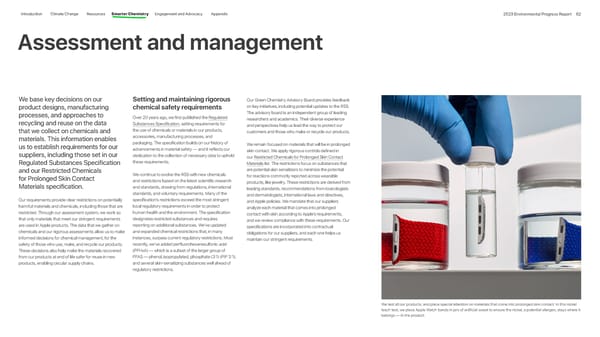Introduction Climate Change Resources Smarter Chemistry Engagement and Advocacy Appendix 2023 Environmental Progress Report 62 Assessment and management We base key decisions on our Setting and maintaining rigorous Our Green Chemistry Advisory Board provides feedback product designs, manufacturing chemical safety requirements on key initiatives, including potential updates to the RSS. processes, and approaches to The advisory board is an independent group of leading Over 20 years ago, we first published the Regulated researchers and academics. Their diverse experience recycling and reuse on the data Substances Specification , setting requirements for and perspectives help us lead the way to protect our that we collect on chemicals and the use of chemicals or materials in our products, customers and those who make or recycle our products. materials. This information enables accessories, manufacturing processes, and us to establish requirements for our packaging. The specification builds on our history of We remain focused on materials that will be in prolonged advancements in material safety — and it reflects our skin contact. We apply rigorous controls defined in suppliers, including those set in our dedication to the collection of necessary data to uphold our Restricted Chemicals for Prolonged Skin Contact Regulated Substances Specification these requirements. Materials list. The restrictions focus on substances that and our Restricted Chemicals are potential skin sensitizers to minimize the potential for Prolonged Skin Contact We continue to evolve the RSS with new chemicals for reactions commonly reported across wearable and restrictions based on the latest scientific research products, like jewelry. These restrictions are derived from Materials specification. and standards, drawing from regulations, international leading standards, recommendations from toxicologists standards, and voluntary requirements. Many of the and dermatologists, international laws and directives, Our requirements provide clear restrictions on potentially specification’s restrictions exceed the most stringent and Apple policies. We mandate that our suppliers harmful materials and chemicals, including those that are local regulatory requirements in order to protect analyze each material that comes into prolonged restricted. Through our assessment system, we work so human health and the environment. The specification contact with skin according to Apple’s requirements, that only materials that meet our stringent requirements designates restricted substances and requires and we review compliance with these requirements. Our are used in Apple products. The data that we gather on reporting on additional substances. We’ve updated specifications are incorporated into contractual chemicals and our rigorous assessments allow us to make and expanded chemical restrictions that, in many obligations for our suppliers, and each one helps us informed decisions for chemical management, for the instances, surpass current regulatory restrictions. Most maintain our stringent requirements. safety of those who use, make, and recycle our products. recently, we’ve added perfluorohexanesulfonic acid These decisions also help make the materials recovered (PFHxA) — which is a subset of the larger group of from our products at end of life safer for reuse in new PFAS — phenol, isopropylated, phosphate (3:1) (PIP 3:1), products, enabling circular supply chains. and several skin-sensitizing substances well ahead of regulatory restrictions. We test all our products, and place special attention on materials that come into prolonged skin contact. In this nickel leach test, we place Apple Watch bands in jars of artificial sweat to ensure the nickel, a potential allergen, stays where it belongs — in the product.
 Apple Environmental | Immersive Page 61 Page 63
Apple Environmental | Immersive Page 61 Page 63